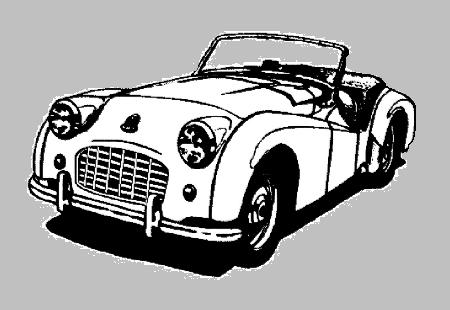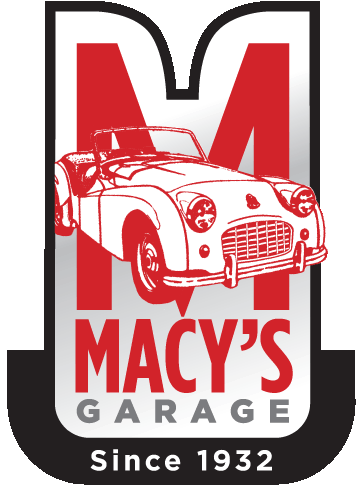
 TR2-4 Rear Differential Overhaul
TR2-4 Rear Differential Overhaul
|
Macy's Garage, Ltd. America's BEST Triumph Shop! |
Tools and tips for overhauling Triumph TR2-4 rear differentials
Let me begin by saying that I do not intend to re-write the factory workshop manual with regard to rear end service. This is a supplemental article to demonstrate a) what a huge job this is , and b) how I came up with substitutes for all of the special tools demonstrated in the Standard-Triumph Service Instruction Manual (TR2-3) or Workshop Manual (TR4-4A). This also will not address rear axle bearing and seal replacement, which can be performed without overhauling a differential.
As always throughout my site, click on the thumbnail photos for a larger view. Use your browser's BACK button to return.
| Understand that you will not be performing rear end service with the unit in the car. The spare tire well is too close to remove the internal parts. Arrow points to a recess used to apply pressure to the case and spread it open (later). Most folks performing a full frame up restoration will only sandblast and paint the rear axle. This is a shortcut you really shouldn't take. | And here's why you want to overhaul your rear differential, especially if the car has sat idle for a number of years. Pitting on this carrier bearing and race was caused by rust. On a car which has sat idle for years, oil drains off of the internal parts, and moisture from humidity finds its way in through the breather opening causing unseen damage. | The first tool you'll need is a casing spreader, Churchill S101. You'll never be able to find one! I made mine from 3/8" bar stock, 1" pipe, and 3/4" fine threaded rod. The small bolts are grade 8, and close to the edge of the bar stock, so 1/2" bolts were tapped into the bar stock at the location of the depressions shown in photo #1 to help push. Jam nuts are used on the 1/2" bolts to lock in place. |
| Here's the spreader in place on the rear housing. Use the longest wrenches you have, as this will require a terrific amount of force to obtain the few thousandths needed to extract the differential from the housing. You will also need to apply and release the pressure several times throughout the overhaul process. | With the differential unit removed, the pinion can be driven out as shown in the factory manual. They recommend a hide faced hammer, but any soft copper or brass hammer will work just as well. Reinstall the nut (upside down) after removing the flange just to be sure you don't damage the threads. | The next Churchill tool shown in the manual is TS1 and S4221 to remove the head bearing from the pinion gear. I opted to do this in my press with a bearing separator placed below the bearing. You will need a hydraulic press such as this many times during a rear end overhaul to remove and install bearings and races. |
| Carrier bearings are removed with Churchill tools S103 and S4221, but a universal bearing separator and puller will do the same job. I purchased an optional stepped washer to fit in the end of the carrier which gives the puller something to push against. This unit will not fit in the large press for bearing removal. | Here's the complete Bearing Separator Push - Puller set. This is an OTC 4518. You'll want a good set, as many of the bearings have to be removed and installed several times as you check for clearances without shims, then remove bearings and races to add shims, then re-assemble to check for proper clearances until you get it right. | Pinion bearing races are driven out with Churchill tool 20SM and FT71, or use a brass drift and big hammer. Just FYI, for the larger pinion head bearing race you will be driving against shims, all of which will be destroyed and need to be replaced. |
| Here's what you get when everything is apart. While you're in here, I recommend wholesale replacement of all bearings and races. You wouldn't want to have to go back and ever do this job again! Rear axles are shown apart as part of a complete overhaul, but are not addressed in this article. | A good micrometer will be necessary for reassembly to verify shim thickness, both old and new. You should be proficient at using it too! | Dial calipers are also mandatory for overhauling a rear end. Here we measure the pinion head thickness because Triumph set the pinion depth from the bottom of the pinion with a special tool, and we'll have to measure from the top of the pinion with modern tools. Math to 4 decimal places will be required! |
| A dial indicator and magnetic base is another must have for this job. You'll need it to measure the carrier run out, casing end float, crown wheel and pinion backlash, and for checking and adjusting the axle end float on both sides. | The workshop manuals show that Churchill tool M70 was needed to install the pinion head and tail bearing races, so I made something similar out of some remaining 3/4 threaded rod from the case spreader. | While my home made tool did work, it was a struggle. Especially for the head bearing race, which is always a very tight fit. This race is another one that is in and out several times during the process to fit the shims which control the pinion depth. |
| A nice bearing race and seal driver set like this Lisle 12800 is a great tool, especially for installing axle seals in the rear end housing, but it was no match for the pinion head bearing race. | In the end, I found that the 20 ton press and the proper assortment of washers, pipe nipples, and steel bars resulted in the easiest way to install this difficult bearing race back into the rear end housing. | Tool S103 and press S4221A are recommended to fit the head bearing on the pinion, and in a similar operation tools S100 and handle #550 are specified to install the carrier bearings to the differential. With the right diameter and length of pipe to push the inner bearing races, both can be installed in the hydraulic press. |
| The factory utilized a dummy pinion and gauge (M84) to check the pinion depth, and that's another tool you'll probably never ever find. Here is my Powerhouse Products POW356000 pinion depth setting tool in action. This is done by a completely different method than what's shown in the manuals, so if you're going to buy this tool, buy the video that goes with it too or you'll never figure it out! The video is POW902070. | Once again, special tool 20.SM.98 is recommended to check the pinion bearing pre-load. This can be easily accomplished with a torque wrench calibrated in inch-pounds. You'll get plenty of practice with this, as the pinion will be in and out of the housing several times until you find the right combination of shims to get the pre-load within the correct range. | Here's the completed differential, all nice and clean inside with fresh bearings, seals, and correct clearances. Start to finish, this is a 10-12 hour job when all of the right tools or acceptable substitutes are on hand. Without the tools, there's no possible way that you'll be able to accomplish this job and build a rear end that will last for very many miles. To purchase and make all of the tools shown here is a sizeable investment, so if you only plan on doing one rear end it will be far more economical to ship your rear differential here to Macy's Garage or find someone locally who has plenty of experience with Triumph rear ends (and the tools). |













